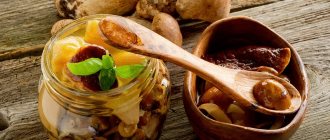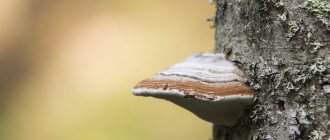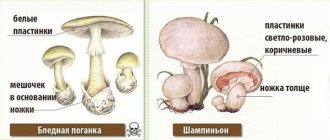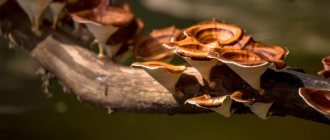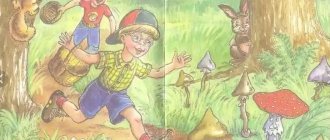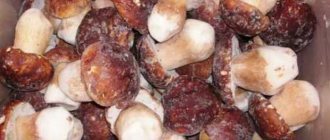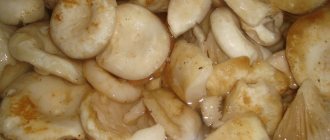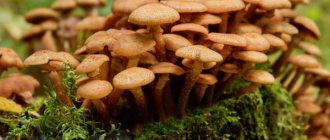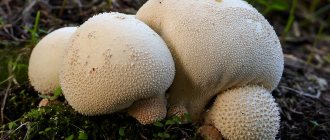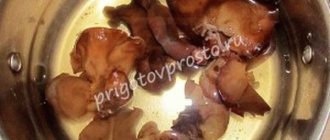The territory of the Altai Territory is rich in its huge forests, the area of which reaches 10 million hectares. Mushrooms are directly related to the forest, so in the Altai region you can collect very high-quality harvests. In a favorable season, one mushroom picker can collect up to 12 buckets in just one trip to the forest. Mushrooms grow not only in forests, but also on hills and steppes. In total, in the Altai Territory there are about 200 species of edible and only 6 species of poisonous and inedible mushrooms.
Poisonous specimens
There are many poisonous mushrooms growing in the Altai Republic.
The greatest danger is represented by toadstool, the consumption of which leads to death. The poisons contained in it retain their properties during any culinary processing.
In addition to it, in the forest belt you can find gall mushroom and several types of fly agarics. Inexperienced mushroom pickers can be poisoned by mushroom mushroom or false honey fungus.
One of the types of svinushka - thin svinushka, until 1984 in the USSR belonged to the group of conditionally edible mushrooms. But it was excluded from it and classified as poisonous. As it turned out, when consumed as food in the human body, processes began to accumulate a special compound in the blood - an antigen, which settled on the surface of red blood cells. After the death of its carrier, this compound is transferred to a new blood cell. As a result, a response occurs in the body and conditions develop that lead to death.
When collecting honey mushrooms, you need to be especially careful and take only young specimens that have all the characteristics characteristic of the species. And it’s better for a novice mushroom picker to go into the forest with a mentor-guru who can help him solve the problem “Should I take this mushroom or not?”
Preparation
Dishes with mushrooms are appropriate for both everyday and festive tables. White mountain has excellent taste and quite impressive size. The taste and aroma of these mushrooms allows them to be used as a main or additional ingredient in a variety of cooking options. However, you should remember about mandatory heat treatment.
Cleaning
As you know, mushrooms are a fairly perishable product; they cannot last long. Cleaning is the first stage of preparation for further processing. First, the mushrooms should be thoroughly washed and dried. While the product is drying, you can prepare your cleaning tools.
You will need:
- Bowl;
- sharp knife;
- a small brush (an unnecessary toothbrush will do);
- towel.
Next you need to act in the following sequence:
- Cut off the lower part of the stem of the fruiting body, simultaneously clearing the contaminated layer with a knife.
- Use a towel to remove excess moisture.
- Next, the product is placed in salted water for fifteen minutes.
- Then the remaining dirt and the top layer, which does not contain useful substances, are removed with a brush.
- Rinse again under running water.
Each mushroom should be carefully examined for the presence of worms. If passages left by pests are found in the leg, it should be thrown away. You should also cut off and discard all darkened areas. Only after this processing is the product ready for further preparation.
Important: if you plan to dry the mushrooms, you cannot wet them; you should use a regular paper napkin.
Cooking
Boil the mushrooms for 30–40 minutes. However, if they are then fried, then twenty minutes of heat treatment is sufficient. Peeled and chopped fruiting bodies are poured with cold salted water, which should completely cover them. Then the pan is put on fire.
The dried product is soaked for several hours, then boiled for twenty minutes. Frozen mushrooms take the same amount of time to cook; no preliminary defrosting is required.
You can cook it in a slow cooker, which almost every housewife has these days. To do this, select the “Baking” mode and cook for forty minutes. The same amount of time will be needed for cooking in a double boiler.
Important: during the cooking process, any foam that forms should be removed.
Freezing
Frozen fruits and vegetables are often used to prepare various dishes during the winter season. Mushrooms are no exception. You can use them to prepare flavorful soups, pies and stews.
Freezing this product is very simple - just cut them after cleaning and place them in portions in a suitable container. Since food frozen and thawed several times loses its taste, it is recommended to choose a container of the appropriate size so that it can accommodate one required portion. It is important to remember that only thoroughly dried fruit bodies are frozen.
Frying
Fried porcini mushrooms have a unique aroma and are a great addition to any table. You can fry them pre-cooked or raw. If the product has been boiled, then cook in a frying pan for twenty minutes.
In the case of raw mushrooms, you need to fry them for half an hour over low heat. You can add onions or sour cream to taste. At the end of cooking, the dish should be salted.
Pickling
Pickling is a favorite way of processing mushrooms. There are many types of pickling, with or without spices. For the simplest thing, you will need mushrooms and salt. For a bucket of whites you need to take two glasses of salt.
The cooking method is as follows:
- After thoroughly cleaning the main ingredient, it is necessary to separate the stems from the caps. The latter should be cut into several parts.
- Rinse under running water.
- Pour cold water over all the resulting pieces and put on fire.
- After boiling, place in a colander and cool.
- While the mushrooms are drying, you should prepare a container for pickling.
- The fruiting bodies are placed in a pan and sprinkled with a layer of salt about a couple of centimeters on top.
- Place a pressure that should completely cover the surface.
- The containers should remain in this state for five days at room temperature. During this time, the mushrooms will settle and their number will decrease.
- After five days, you can move the containers to a cooler place for long-term storage.
Another great pickling recipe - porcini mushrooms turn out crispy and aromatic.
You will need:
- main ingredient (1.5 kilograms);
- a small bunch of thyme;
- garlic (2 heads);
- dill umbrellas (2 sprigs);
- horseradish, currant and cherry leaves;
- salt (4 tablespoons).
The salting sequence is as follows:
- Cut processed and clean mushrooms into several pieces.
- Remove the husks from the garlic and separate it into cloves. Cut each tooth.
- Wash all greens under running water.
- Pour boiling water over a large capacity container prepared in advance and dry.
- Layer layers of horseradish leaves, mushrooms, salt, garlic, thyme and dill, cherry and currant leaves. Repeat the sequence until the main ingredient is gone.
- A heavy weight is placed on top.
- The container should be kept in a cool place for a week.
Canning for the winter
Jars of canned porcini mushrooms will be an excellent addition to the holiday table. In order to marinate the talker, you will need:
- purified main ingredient - 1 kg;
- water – 400 ml;
- sugar – 1 tbsp. l.;
- vinegar 9% – 2 tbsp. l.;
- salt – 3 tsp;
- bay leaf, allspice, cloves - 2 pcs.
Preparation:
- First, the mushrooms are boiled for twenty minutes.
- In the meantime, prepare the marinade: add salt, sugar and vinegar to boiling water and bring to a boil.
- Govorukhi is placed in the marinade and cooked for five minutes.
- In pre-prepared jars, you need to put bay leaves, cloves, pepper on the bottom, and pickled pigs on top.
- Roll up.
Mushrooms are a favorite delicacy for many; dishes containing them have a unique taste and aroma. In addition, silent hunting is a fascinating process. But when picking mushrooms, you should be extremely careful not to put life-threatening, poisonous specimens into the basket. Only after careful processing and preparation can mushrooms be eaten.
Map of mushroom places
The peak mushroom season occurs from late July to mid-September. If the summer is warm and humid, you can expect a rich harvest.
Most mushrooms appear in the Volchikhinsky and Talmensky districts of the Altai Territory.
In addition, experienced mushroom pickers advise studying the map and visiting the forests in the vicinity of the following settlements:
- Malyshev Log;
- Larichikha;
- Ozyorsk;
- Shipitsyno;
- Mamontovo:
- Trinity.
Boletus lovers should remember the villages of Pankrushikha and Maslyakha. If you decide to collect chanterelles and boletus, then you need to go to Rebrikha or Pervomaiskoye.
Milk mushrooms grow near Polovinkino and Saratovka. In addition, many mushroom places are located near Barnaul.
Where and when does the porcini mushroom grow in the Altai Territory
Porcini mushroom is perhaps the most healthy, aromatic and tasty of all types. It contains large amounts of vitamin A, B1, C and D, and is also low in calories.
Description
This is a bright representative of the Borovikov family. There are many color options for its cap: from light to dark brown with a red tint. The shape of the cap depends on the “age” of a particular fruit: for a small one it is spherical, and then it becomes cushion-shaped. Its diameter is on average 25 cm, and the surface is smooth, slightly velvety.
The pulp of this part of the boletus is white, which does not change when cut, and is also dense. At the same time, it is practically odorless, but has a nutty taste. The leg is massive: its height can reach 20 cm and thickness - 5 cm. It has the shape of a cylinder and a white or light brown tint.
Places of growth
Porcini mushrooms grow on all continents, with the exception of Australia and Antarctica. The most favorable places for them are coniferous or coniferous-deciduous forests, as well as soils covered with moss and lichen. The ideal conditions for boletus are warm and moderately humid weather with foggy nights.
The porcini mushroom is considered inedible in Switzerland.
Collection season in the Altai Territory
The very first boletus mushrooms appear in mid-June . Experienced mushroom pickers, who know when to pick porcini mushrooms in the Altai Territory, advise going on a “quiet hunt” a week after heavy rain, in warm weather - these are the best conditions for fruit ripening.
Here the mushroom season begins in mid-July and lasts until the first frost. However, the largest number of boletus mushrooms can be found in August - early September.
Mushroom places
Based on the opinion of experienced mushroom pickers, a list of mushroom places in the Altai Territory was compiled.
It includes the following areas:
- Rebrikhinsky;
- Mamontovsky;
- Volchikhinsky;
- Rubtsovsky;
- Novichikhinsky;
- Blagoveshchensky;
- Trinity;
- Talmensky;
- Kamensky;
- Krutikhinsky;
- Biysk;
- Romanovsky;
- Pankrushikhinsky;
- Zarinsky.
This is where all those who like to collect boletus mushrooms go in late summer - early autumn.
Doctors say the number of cases of poisoning by this product is increasing, so you need to remember the rules for choosing and collecting mushrooms before you go looking for them.
Harvest Application
Mushrooms contain a lot of vitamins
Methods for harvesting and processing mushrooms depend on the tastes of a particular person.
- Boletus, boletus and porcini mushrooms can be dried for the winter.
- Milk mushrooms, milk mushrooms and saffron milk caps are most often salted or consumed with boiled sour cream.
- Butternuts and chanterelles are good fried. Before use, the butterdish cap must be cleared of its thin skin. Chanterelles reveal their rich flavor when butter is used.
- Honey mushrooms are used for pickling.
Pour the fried mushrooms well with melted butter and store them in a cool place. When winter comes, you will be able to enjoy the gifts of the forest, which will not lose their taste.
Exotic lovers can enjoy the sulfur-yellow tinder fungus. Only young specimens eat. Before use, boil for 25-30 minutes. The mushroom has a pleasant aroma and slightly sour taste.
Particular care must be taken when preparing conditionally edible mushrooms. They need pre-cooking and soaking. In some cases, to remove toxins it is necessary to repeat these procedures 2-3 times. This is exactly what they do with strings and morels, the fruiting bodies of which contain a toxic substance called gyromitrin.
What mushrooms grow in the Altai Territory
The Altai region is famous for its vast forests. They occupy about 10 million hectares. And where there is a forest, there are mushrooms. There are many mushroom places in Altai with rich harvests. In favorable years, mushroom pickers collect from 5 to 12 buckets in one day. According to biologists, the mushrooms of the Altai region are represented by 200 species of edible and 6 species of poisonous and inedible.
Mushrooms of the Altai region
Edible mushrooms
Tubular mushrooms of the 1st category (edible, or unconditionally edible) are quite widely represented on the territory of the region:
- White mushroom;
- boletus;
- boletus;
- 2 types each: saffron milk mushrooms, cap mushrooms, talker mushrooms, oyster mushrooms, honey mushrooms, umbrella mushrooms, dung beetles, scaly mushrooms;
- 3 types each: champignons, row, float, cobweb;
- 4 types of milk mushrooms;
- 5 types of russula;
- fox;
- whitefish;
- violin;
- pink wave;
- chestnut colibia;
- purple moth;
- Serushka.
There are also lamellar mushrooms, but an inexperienced person should not collect them. Even among fly agarics there is an edible one - float, but it is better not to collect it for those who do not understand mushrooms, so as not to stumble upon its poisonous counterparts.
Poisonous mushrooms
Poisonous mushrooms growing in Altai:
- fly agaric of 3 types: smelly, red, bristly;
- death cap;
- gray-yellow false honey fungus;
- gall fungus;
- thin pig;
- common false raincoat.
Varieties
- White (or boletus): prized for its large size and excellent taste. The first name comes from the fact that the bottom of the cap and the flesh do not change color after drying. Its dimensions range from 8 to 19-20 cm. It grows under birch, pine and other trees. The leg is thick, stretches up to 17 cm. Suitable for frying, boiling, pickling. Dried ones are stored hanging.
- Boletus (or aspen): a large mushroom with a cap from 25 to 30 cm, with tight, dense flesh. The leg grows up to 20 cm. The name is conditional - it grows not only among aspens, but also in mixed forests. Good for use in any form.
- Boletus: the cap can be of different sizes - 3-16 cm, with a white “inside”, a high stem of about 20 cm. It grows both in birch forests and in forests with a predominance of birch. Used in all forms, except salted.
Boletus is good in any form
- Saffron milk caps: bog and spruce. You can recognize them by their cap pressed inward, their color ranges from red to orange, and their stem is hollow. Depending on the appearance, it can be found in pine or spruce forests. Very valuable and tasty among edible varieties, they can be collected at an early age. Good dried.
- Russula: in the Altai forests the presence of 6 species was noted (green russula, food russula, yellow russula, marsh russula, blue russula, golden-red russula). The species are named according to the different colors of the cap, the width of which ranges from 7-15 cm, the stem from 5 to 10 cm. The place of growth is most often in pine-deciduous forests. You can dry, salt, boil, fry.
- Champignon: in the region it is represented by the following species: w. ordinary, w. field, sh. forest. The cap depends on the size of the mushroom - 3-20 cm, with white flesh, a high stem with a height of 10 to 19 cm. It loves manured lands, so it often grows in vegetable gardens, farms, around pastures, clearings among coniferous and mixed forests. Champignons are considered to be quite valuable mushrooms, because in their high nutritional qualities they are equal to meat. Used for boiling, pickling, stewing, drying, canning.
- Oyster mushroom: there are 2 species - c. ordinary and c. autumn Named from the word "spring" - this is the moment when it begins to grow. It is distinguished by a cap tilted to one side with a diameter of approximately 15 cm, a small leg 2.5-4 cm in height, which grows on the side of the cap. Develops on stumps, trunks, and living trees. Suitable for salting, pickling, cooking.
Irina Selyutina (Biologist):
While the oyster mushroom is well known to us, we know a little less about its companion. The surface of its cap in young specimens is mucous, then velvety-felt. The edge of the cap of young specimens is turned up. The flesh is fleshy, colored white or light cream. Under the cuticle of the cap, and sometimes above the plates, the hymenophore acquires a gelatinized mass. According to some sources, the smell is absent, but according to others it is pleasant, reminiscent of plant freshness. With age, the pulp changes from dense and loose to hard and at the same time rubbery. In damp weather, due to the absorption of additional moisture, it is watery. The taste can be bitter and, interestingly, the bitterness appears after frost. Refers to conditionally edible mushrooms. Young specimens can be consumed only after at least 15 minutes of preliminary boiling. The decoction is not used for food.
- Honey fungus: you can find representatives of 2 species - o. summer and o. autumn. The size of the cap is 7-9 cm, the long stem is from 8 to 15-16 cm. Place of growth - stumps, dead trees, dead wood. Suitable for use in soup, salted, dried, fried, pickled.
- Chanterelle: Named because the color of the fruiting body is similar to the fluffy coat of a fox. The hat is 3-10 cm wide, with a long stem. One of the most common mushrooms in the Altai region. It is used in all types.
- Milk mushrooms: represented by species - true g., aspen g., blue g., black g. (nigella). They are classified as conditionally edible - suitable for consumption in salted form. They are an excellent option for pickling. They have dense, large caps, white flesh, a thickened stem, and bitter milky juice, due to which the mushrooms have to be soaked for one to several days before pickling, depending on the type. They are usually collected in birch and aspen forests. Doesn't come across very often.
Mushroom places
- Barnaul, Burlinsky, Kasmalinsky and Kulundinsky forests: many mushrooms are found here.
- Upper Ob and Middle Ob forests: these areas are rich in different types of mushrooms. You can make a rough map based on where they grow.
- Volchikhinsky, Krutikhinsky and Pankrushikhinsky districts: forests in these areas are famous for the abundance of boletus.
- Talmensky and Zarinsky districts: they are distinguished by a rich range of different edible and conditionally edible species.
- Mamontovsky and Rubtsovsky districts: white and milk mushrooms are found in their territories.
- Blagoveshchensky, Romanovsky and Biysky districts: attract fans of “silent hunting” with white and boletus.
- the villages of Pavlovsk and Zalesovo: moving in their direction you can always find honey mushrooms, butter mushrooms, moss mushrooms, milk mushrooms.
- Rebrikha and Troitsky districts: in these places you need to look for chanterelles, honey mushrooms, and boletus mushrooms.
- Novichikhinsky district: its areas are known for milk mushrooms, boletus, and white mushrooms.
Champignon
Champignons are universal in use
These mushrooms grow mainly in fields due to nutritious organic fertilizers, as well as on the edges of forests. Champignons are a lamellar species. The cap size is from 2 to 10 in diameter. The color of the pulp is white, with a dark base under the plates.
Classified as edible. The peak of fruiting occurs at the end of June, but the fruits are found until the beginning of September.
Application
Champignon is the most popular genus used in cooking. Mushrooms of this genus are suitable for pickling, frying and stewing. They are also eaten raw and pickled.
False doubles
The disadvantages for champignon include its similarity to toadstool. This poisonous analogue is fatal to humans.
There are several ways to distinguish champignon from toadstool:
- The plates of the poisonous double are white. But the champignon has pink or brown hymenophore components.
- After damage, the flesh of the champignons turns light red or yellow. In the grebe such changes do not occur.
- The pale grebe (young) has no odor. The aroma of champignons is reminiscent of anise or nut.
Places of growth
The largest growing area for champignons in the Krasnoyarsk region is the forest around the village of Ploskoye. It can be reached along the highway that passes through the village of Emelyanovo. From the village of Ploskoye you need to turn southeast and drive 5 km.
Composition of mushrooms, benefits
The mushroom composition contains up to 90% water, and the dry part is predominantly protein. That is why the gifts of the forest are often called “forest meat” or “forest bread”.
- Mushroom protein contains almost all amino acids, and even essential ones. Mushrooms are an important part of the diet, however, due to the fungin content, it is better to exclude them from the menu for people suffering from kidney, liver and gastrointestinal diseases.
- There are much fewer carbohydrates in “forest meat” than protein. Mushroom carbohydrates differ from plant carbohydrates and are better absorbed, much like milk or bread carbohydrates.
- Fatty substances are absorbed like animal fats by 92-97%.
- The composition contains tartaric, fumaric, citric, malic and other acids.
- The composition contains a large amount of vitamins PP, B1, A. Some varieties contain B2, C, D.
- Mushrooms are rich in iron, phosphorus, calcium, sodium, potassium.
- The composition contains microelements - zinc, fluorine, manganese, iodine, copper.
Edible forest products have many benefits; since ancient times they have been used to treat diseases. Nowadays it is a healthy and tasty food, and vegetarians replace meat with it.
Mushrooms can boost immunity, cleanse blood vessels and lower cholesterol levels, fight depression and excess weight. They help maintain the beauty of hair, skin and nails. Read more about contraindications and beneficial properties of mushrooms on our website.
How to pick mushrooms correctly
When collecting mushrooms, it is better not to pull them out or cut them, but to twist them out of the substrate, and only after that cut off the dirty base of the stem.
As for eating mushrooms, experts do not recommend getting carried away with them. The cell wall of fungi consists of chitin, and the human body is not able to produce enzymes that can destroy chitin. In this regard, most compounds in mushrooms are only partially absorbed. Those who have problems with the gastrointestinal tract and children under seven years old are not recommended to eat mushrooms.
Article sources
To write this material, materials were used from the sites:
www.biolokus.ru
www.katun24.ru
www.fermer.blog
www.news.myseldon.com
www.visitaltai.info
